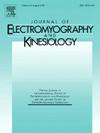Neuromechanical adaptation of a perturbation protocol during treadmill running
IF 2.3
4区 医学
Q3 NEUROSCIENCES
引用次数: 0
Abstract
The ability to adapt to unexpected changes in environments is associated with the risk of running-related injuries. Although gait retraining programs can mitigate injury risk, there is a scarcity of studies focusing on neuromechanical adaptations during running with unpredictable perturbations. Hence, the current experiment aimed to analyse spatial–temporal and muscle activity adaptation during a perturbed running protocol. 23 participants performed a 5-minute unperturbed and an 8-minute perturbed running trial with a baseline velocity of 2.5 m/s. During the perturbation protocol, 30-one-sided decelerative perturbations were randomly applied to both legs. Spatial-temporal data and muscle activity of twelve lower extremity and trunk muscles were recorded during unperturbed and perturbed steps. Linear mixed models with repeated measures were applied to identify adaptation at any time point in the data. Statistical analysis indicated adaptation to the perturbation trial in comparison to baseline trial for step duration, length, width and upper- and lower-leg muscles. Adaptations characterized by decreased step duration and length and increased step width and muscle activity. This study has demonstrated participants’ ability to adapt their movement and muscle activity patterns while running with unpredictable perturbations. Therefore, introducing more diverse or novel perturbation stimuli to the human system may be necessary to continually challenge adaptation.
在跑步机上跑步时扰动协议的神经机械适应性
适应环境意外变化的能力与跑步相关伤害的风险有关。尽管步态再训练计划可以降低受伤风险,但在不可预测的扰动下跑步时神经机械适应性的研究很少。因此,目前的实验旨在分析空间-时间和肌肉活动适应在一个受干扰的跑步协议。23名参与者进行了5分钟的无干扰和8分钟的干扰跑步试验,基线速度为2.5米/秒。在摄动方案中,30个单边减速摄动随机应用于双腿。在无干扰步幅和受干扰步幅下,记录12条下肢和躯干肌肉的时空数据和肌肉活动。采用具有重复测量的线性混合模型来识别数据中任何时间点的适应。统计分析表明,与基线试验相比,摄动试验在步长、长度、宽度和上下腿肌肉方面适应于摄动试验。适应的特点是减少步长和步长,增加步宽和肌肉活动。这项研究证明了参与者在不可预测的干扰下跑步时适应运动和肌肉活动模式的能力。因此,向人类系统引入更多样化或新颖的扰动刺激可能是不断挑战适应的必要条件。
本文章由计算机程序翻译,如有差异,请以英文原文为准。
求助全文
约1分钟内获得全文
求助全文
来源期刊
CiteScore
4.70
自引率
8.00%
发文量
70
审稿时长
74 days
期刊介绍:
Journal of Electromyography & Kinesiology is the primary source for outstanding original articles on the study of human movement from muscle contraction via its motor units and sensory system to integrated motion through mechanical and electrical detection techniques.
As the official publication of the International Society of Electrophysiology and Kinesiology, the journal is dedicated to publishing the best work in all areas of electromyography and kinesiology, including: control of movement, muscle fatigue, muscle and nerve properties, joint biomechanics and electrical stimulation. Applications in rehabilitation, sports & exercise, motion analysis, ergonomics, alternative & complimentary medicine, measures of human performance and technical articles on electromyographic signal processing are welcome.

 求助内容:
求助内容: 应助结果提醒方式:
应助结果提醒方式:


